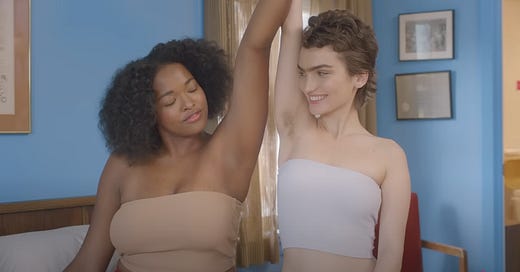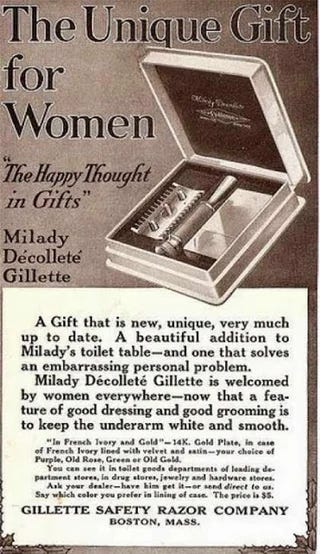Do you remember this Billie ad?
It made waves in 2019 for being the first time a shaving products commercial actually featured body hair. It was a refreshing, and honestly, revolutionizing response to other ads that showed women shaving already-hairless legs. Billie’s marketing included bodies of all shapes, sizes, and skin tones—and all types of body hair too! Not just legs and armpits, but bellies, toes, and eyebrows. The on-screen text reads, “However, whenever, if ever you want to shave, we’ll be here.” A razor ad that acknowledges that shaving is a choice, and not shaving is a completely valid option? That’s undeniably groundbreaking.
However.
While this representation is definitely a major step in the right direction, I think this ad is only feminist on the shallowest surface level. Once you dig a little deeper, you see that Billie is still upholding (and profiting off of) patriarchal beauty standards. Stay with me.
Billie does not actually want you to make the choice to not shave, because if you don’t shave, then they don’t make money. This ad hasn’t sat right with me for a long time, and I want to dissect it using two concepts within gender studies: midriff advertising and choice feminism. I want to make it abundantly clear that I’m not here to tell you that you have to stop shaving in order to be a good feminist, but if you are someone who removes their body hair, I want to challenge you to interrogate why you do it. I stopped shaving a little over seven years ago, and it’s still one of the best decisions I’ve made for myself. From a practical standpoint, I’ve saved so much money on razors and shaving cream, and I’ve saved myself from the pain of nicks and razor burn, but my not shaving is also political statement. It’s a very simple yet effective way to say “fuck you” to patriarchal beauty constructs.
A Brief History on Women’s Body Hair Removal
Whether we like it or not, advertising has the power to shape our social norms. The history of women shaving can be traced back to a Gillette advertisement from 1915. Previously, American razor companies had only ever sold their products for use on men’s facial hair, but this left a huge, very profitable market untapped—American women. Thus, razor companies, beginning with Gillette’s Milady Décolleté, began promoting the idea that women’s body hair was unsanitary, masculine, and embarrassing—an idea that has persisted to this day.
So the entire reason why women are now expected to shave their legs and armpits is because razor companies in the 1910s wanted to make more money. Modern advertising, such as this Billie ad, has seen a shift from trying to illicit new insecurities in women in order to sell them products to marketing to women in a way that feels progressive and empowering. The result is the same, where women are still pressured to comply with patriarchal beauty standards, but the messaging is much more palatable now, which is where midriff advertising comes in.
Midriff Advertising
In her article, Empowerment/Sexism: Figuring Female Sexual Agency in Contemporary Advertising, sociologist and feminist theorist Rosalind Gill outlines a concept she calls “midriff advertising,” which I think perfectly applies to this Billie commercial. The term is derived from a popular theme of ‘90s and 2000s advertising where depicting a young, attractive woman exposing her midriff was meant to symbolize her sexual agency and feminine playfulness. Having the midriff-bearing, sexually-liberated woman in advertisements signaled that the company was modern, progressive, and celebrated female autonomy in hopes that this messaging would attract female consumers. The women in these advertisements still very much fit into a hyper-sexualized male gaze, but they were depicted as choosing it for themselves, thus making it feminist. Right? Gill writes about midriff advertising, “A crucial aspect of both the obsessional preoccupation with the body and the shift from objectification to sexual subjectification is that this is framed in advertising through a discourse of playfulness, freedom and, above all, choice. Women are presented as not seeking men’s approval but as pleasing themselves, and, in so doing, they ‘just happen’ to win men’s admiration.” Gill also identifies four main themes to midriff advertising:
An emphasis on the body.
A shift from sexual objectification to sexual subjectification. (Women as active subjects in sexuality rather than passive objects of sexuality.)
A pronounced discourse of choice and autonomy.
An emphasis on empowerment.
All of these elements are present in this Billie ad. Of course, these products are all about the body, and the people in this ad are depicted as active, autonomous subjects who are making the conscious choice to shave their body hair—not only that, but they derive empowerment from shaving their body hair. Although removing your body hair upholds the patriarchal beauty standard of the hairless female body, Billie purports that as long as you’re making the active choice to conform to this patriarchal beauty standard, then the act of shaving can be empowering. And lucky for you, they’ve got a whole line of empowering hair removal products for you to choose from! This echoes a form of capitalist feminism where instead of achieving liberation through personal freedoms, legal protection, and challenging the patriarchy in any tangible way, women can now achieve empowerment through consuming “empowering” products. It’s incredibly convenient for the patriarchy and for capitalism if women can feel empowered through consumption and through conforming to the male gaze under the illusion of free choice. Gill writes that midriff advertising, “simply sidesteps and avoids all the important but difficult questions about how socially constructed ideals of beauty are internalized and made our own.” How free is your choice to shave when you’ve been conditioned all your life to believe that you have to? Do you really just do it for that smooth, silky feeling?
Choice Feminism
Now, let’s get into the pervasiveness of choice feminism. Gender scholar Moira Donegan writes in her excellent piece, Hard Choices, that under choice feminism, “…any act or circumstance can become ‘feminist’ by virtue of a woman choosing it, or by her finding some sort of satisfaction in it—a satisfaction usually referred to in tellingly nonspecific terms, like ‘empowerment.’” She goes on to write, “The goal becomes not ‘equality,’ but ‘choice’; not ‘liberation’ from sexist structures, but ‘empowerment’ to comply more successfully within them.” Choice feminism is a watered-down, sterilized version of feminism. It loses any ties to activism, liberation, and advancements for women’s rights and instead favors a form of “feminism” that is suspiciously compliant with capitalist patriarchy. How does Billie fit into this? In body hair politics, the real act of liberation would be to challenge the beauty standard and interrogate why women are pressured to shave in the first place. Billie is not advocating for liberation from sexist beauty standards. After all, their ultimate goal is to sell razors, and to achieve that goal, they need women to comply with the sexist beauty standards. The best way to do that in a society that’s increasingly skeptical of women’s beauty expectations is under the guise of feminism and empowerment. It is your choice to shave, Billie proclaims, but let us make it easier for you to make that choice by providing you with the empowering, socially-aware razor. Thanks to Billie, shaving your armpits can be an act of feminism now!
Here’s the Part Where I Lose You
So what’s the alternative? Throw away your razor and grow out your pit hair? Well, yeah kind of. My goal here is not to shame anyone’s choice to shave. As Donegan writes in her article, “…asking an individual woman to justify all her choices in principled feminist terms is like asking her to account for how she has spent every moment of her life, down to the minute.” While I made the decision to stop shaving several years ago, I do still concede to patriarchal beauty standards in innumerable ways every day. I wear makeup, wear my hair long, and present in a conventionally feminine way. It would be completely hypocritical of me to tell anyone that they can’t be a real feminist and shave their legs. These beauty standards are deeply ingrained and incredibly hard to break out of when you’ve been told your whole life that one of your main obligations is to be attractive. My hope instead is to challenge your ideas about beauty standards and societal conventions, and encourage you to critically consider any piece of media that purports to be progressive or empowering while also trying to sell you something. I’d also encourage you to examine your personal choices and be honest with yourself about why you’ve chosen them. Although it may be uncomfortable to go out with a bare face or visible body hair, it is the simplest and most effective way to actually challenge patriarchal beauty standards. Donegan writes that choice feminism, “does not see any difference between the worthiness of a choice to cooperate with patriarchy and the worthiness of a choice to resist it. But there is a difference. It is better to resist.”
The points I want to leave you with:
The goal of midriff advertising is to sympathize with female anger and the desire for liberation, but its underlying message is one that reinforces patriarchy and capitalism.
Choice feminism erases the differences between choosing to comply with patriarchal expectations and choosing to defy them, but liberation can only be achieved through resistance.
Liberation can never be won through consumption.
This Billie ad exemplifies the characteristics of midriff advertising and choice feminism. It co-opts the language of feminism and women’s autonomy on the surface, but its underlying message is one of patriarchy and consumption.
One of the most revolutionary things anyone can do is accept their body exactly as it is.
Further Reading/Research on Body Hair Politics:
*Empowerment/Sexism: Figuring Female Sexual Agency in Contemporary Advertising* by Rosalind Gill (Article)
Hair Removal by the Smithsonian Institute (Article)
Hard Choices by Moira Donegan (Article)
Infantilization and the Body Hair Debate by Shanspeare (Video Essay)
Photos of Shaving Ads from the Last 100 Years by Marlen Komar (Article)
The Secret History of Hair Removal by Rose Lander (Article)
Unshaved: Resistance and Revolution in Women’s Body Hair Politics by Breanna Fahs (Book)
You can find more of me on Instagram, Pinterest, Spotify, and Goodreads. Please consider supporting my work by becoming a paid subscriber, or leaving a tip. <3








Whoa! Very much food for thought. A fresh and unique perspective on this ad. Really loved reading through this one! Much to unpack….